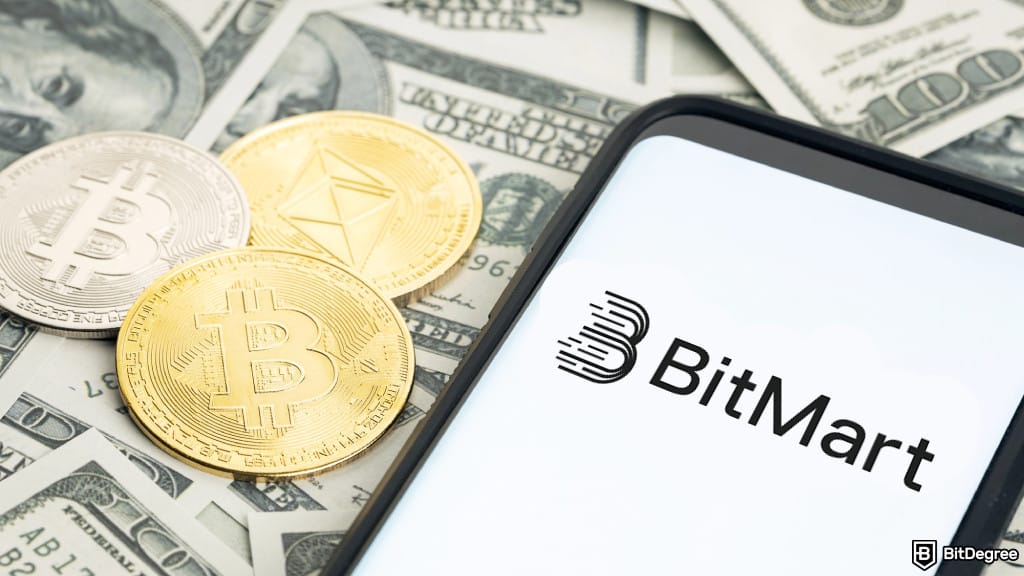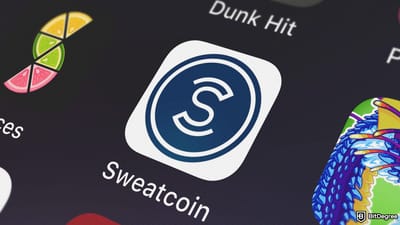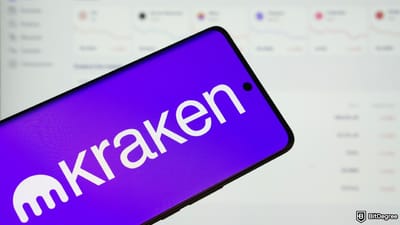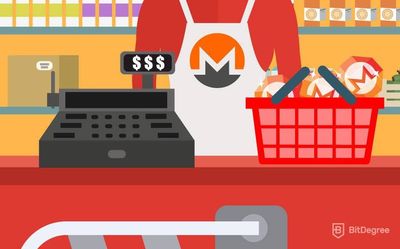Key Takeaways
- BitMart crypto deposits and internal transfers are free, while withdrawals vary by coin and network conditions;
- BitMart’s fees are on par with platforms like Binance, Bybit, and Kraken for most casual traders, though active users might want to compare to see where they benefit most;
- You can lower BitMart trading fees by paying with BMX, using limit orders for lower maker fees, and trading during promotions.
Stop overpaying - start transferring money with Ogvio. Sign up, invite friends & grab Rewards now! 🎁
No one likes hidden fees, especially in crypto. Whether you're trading casually or growing your portfolio, knowing exactly what you’re paying can make all the difference. That’s why I’m breaking down BitMart fees in plain language: from deposits and spot to futures and more.
BitMart is a global crypto exchange with a huge range of tokens and a beginner-friendly interface. Traders can find everything from meme coins to futures contracts. Plus, unpacking the fee system gives you a clue to get the most out of the platform.
So, how do BitMart fees compare to platforms like Binance, Kraken, or Bybit? This guide covers it all - where BitMart saves you money, where it doesn’t, and how to trade smarter if you’re using it.

Did you know?
Subscribe - We publish new crypto explainer videos every week!
How to Pick the Right NFTs? (Animated DOs & DON'Ts)
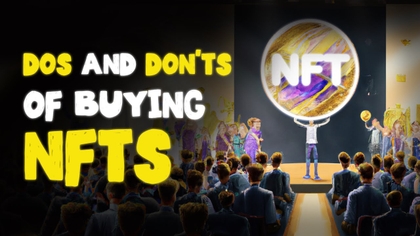

Table of Contents
- 1. BitMart Fees Breakdown
- 1.1. BitMart Deposit Fees
- 1.2. BitMart Withdrawal Fees
- 1.3. BitMart Internal Transfer Fees
- 1.4. BitMart Spot Trading Fees
- 1.5. BitMart Margin Trading Fees
- 1.6. BitMart Futures Trading Fees
- 2. Other BitMart Fees
- 2.1. VIP Fees
- 2.2. API VIP Fees
- 2.3. Liquidity Provider Programs
- 3. BitMart Fees: What Users Say
- 4. Comparing BitMart Fees With Other Exchanges
- 4.1. BitMart Fees VS Binance Fees
- 4.2. BitMart Fees VS Bybit Fees
- 4.3. BitMart Fees VS Kraken Fees
- 4.4. BitMart Fees VS Coinbase Fees
- 5. Tips to Optimize Your BitMart Fee Spending
- 5.1. Use BitMart Token
- 5.2. Use Limit Orders
- 5.3. Withdraw on Weekends
- 5.4. Time Your Trades During Promotions
- 6. Conclusions
BitMart Fees Breakdown
Even tiny fees can eat into your profits over time, especially if you’re an active trader. That’s why understanding what you’ll be charged, and when, is one of the easiest ways to trade smarter.
Latest Deal Active Right Now:So, where does BitMart stand? Similar to other platforms, BitMart offers a pretty competitive setup. Crypto deposits are free, the trading fees are flat and beginner-friendly, and there are perks if you’re a high-volume trader or holding BitMart Token (BMX).
📚 Read More: BitMart Exchange Review
Plus, BitMart uses a maker-taker model, which means your fee depends on how your order is placed. Makers usually pay less because they add liquidity. Takers pay a bit more for immediate execution.
Now, let’s unpack BitMart fees.
BitMart Deposit Fees
Let’s start with the good news: BitMart doesn’t charge any fees for crypto deposits. You can move your assets from a personal wallet or another exchange without worrying about extra costs on their side.
There is one small exception: the token 10SET currently has a 2% deposit fee. But for most other coins, it’s completely free.
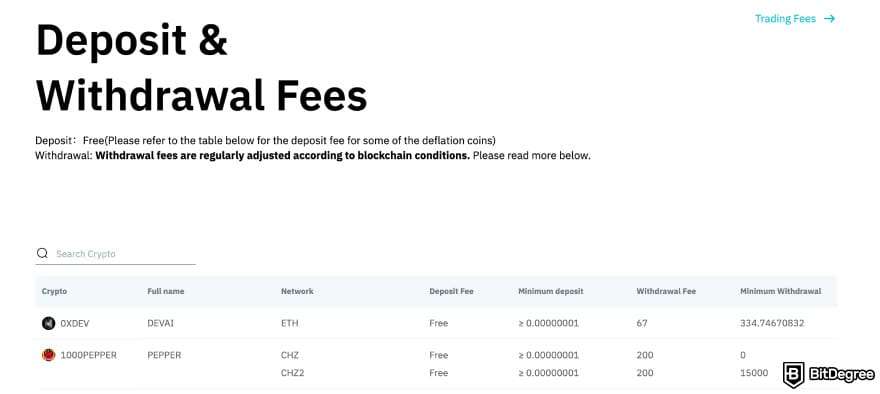
Instead of BitMart deposit fees, you will need to account for network fees. Every time you send crypto, the blockchain itself charges a network fee (also known as a gas fee). This depends on:
- The cryptocurrency you’re using;
- The network it runs on;
- How busy that network is at the time.[1]
Fees vary, and some networks are cheaper than others. I’ll share a few tips for reducing these costs later in the article when we cover how to optimize your BitMart fees.
📚 Read More: Types of Crypto Fees
BitMart Withdrawal Fees
BitMart has various withdrawal fees for each coin, and the rates can still change based on network conditions, similar to deposit fees.
Here’s a quick comparison of withdrawal rates for popular tokens on Ethereum, BNB Smart Chain, and Solana, to help you see where you might save.
Crypto (Full Name) | Withdrawal Fee |
|---|---|
0XDEV (DEVAI) | 67 |
1CAT (Bitcoin Cats) | 10345 |
10SET (10Set Token) | 0 |
1USE (Useless) | 0 |
2024 (2024) | 0 |
A47 (Agenda 47) | 39 |
Table: BitMart withdrawal fees across ETH, BSC, and SOL chains
Note that these are BitMart withdrawal fees at the time of writing. Fees fluctuate often and vary widely based on the token and its network.
Some cryptocurrencies also have a minimum withdrawal amount, while others don’t. So, always double-check BitMart’s withdrawal fee list before moving your funds.
BitMart Internal Transfer Fees
Moving funds within BitMart is the easy part, since you can transfer crypto between internal accounts instantly with no charges. This is similar to the workarounds on top exchanges like Binance.
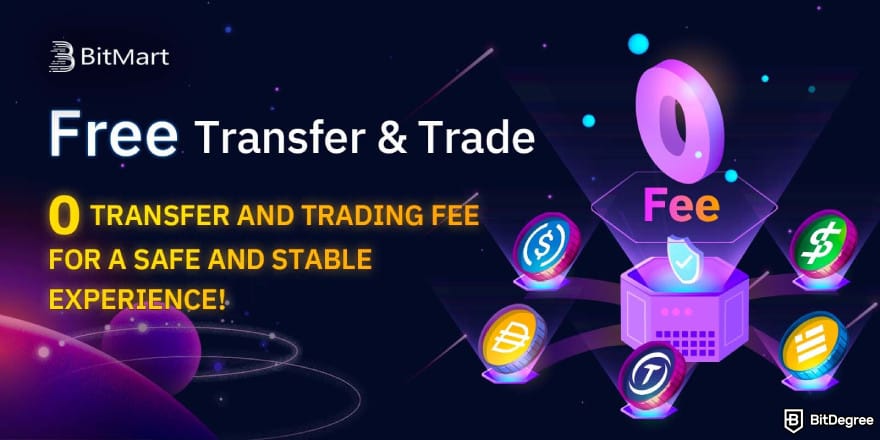 It’s only when you move your assets off the platform, to another exchange or wallet, that withdrawal fees come into play. So if you're just shifting funds internally to trade, you won’t have to worry about extra charges.
It’s only when you move your assets off the platform, to another exchange or wallet, that withdrawal fees come into play. So if you're just shifting funds internally to trade, you won’t have to worry about extra charges.
BitMart Spot Trading Fees
Before we get into the numbers, let’s cover the basics. Spot trading means buying or selling crypto instantly at the current market price. These trades happen on an order book, where makers place limit orders and takers fill them with market orders.
Now, what makes it interesting is that BitMart spot trading fees aren’t flat. Instead, your spot trading fees depend on two things:
- The popularity of the trading pair (called trading classes);
- Your VIP level and BMX balance (which can unlock fee discounts).
BitMart organizes all trading pairs into four classes. Essentially, the more popular the crypto pairing is, the lower the fees you'll have to pay. Here’s a quick breakdown where both maker and taker have the same fees:
Trading Pair | Fee (Maker and Taker) |
|---|---|
Class-A | 0.1% |
Class-B | 0.25% |
Class-C | 0.4% |
Class-D | 0.6% |
Table: BitMart trading pair classes and their fees
BitMart also has 12 VIP levels based on how much BMX you’re holding, but I won’t list them all here. Instead, here’s a quick snapshot of how the fees drop as your level goes up:
Level | Total BMX Balance | Fees Before Discount | Fees After Discount |
|---|---|---|---|
Level 1 | <20,000 | 0.1% (maker) / 0.1% (taker) | 0.0750% (maker) / 0.0750% (taker) |
Level 7 | >400,000 | 0.065% (maker) / 0.070% (taker) | 0.0488% (maker) / 0.0525% (taker) |
Level 12 | >900,000 | 0.04% (maker) / 0.045% (taker) | 0.03% (maker) / 0.0338% (taker) |
Table: Overview of BitMart fees for spot trading
The discount rates show the 25% savings when you choose to pay fees with BMX, a nice little perk for holding their native token.

Did you know?
Subscribe - We publish new crypto explainer videos every week!
What is Fantom? | Animated FTM Explainer


BitMart Margin Trading Fees
Going into margin trading, BitMart’s lowest interest rate is 0.00013%, and the highest is 0.057%. There is a lot to go over, so I will only highlight the initial interest rates for the best cryptocurrencies:
- Bitcoin (BTC) = 0.00013%;
- Ethereum (ETH) = 0.002291%;
- Ripple (XRP) = 0.000181%;
- Litecoin (LTC) = 0.002291%;
- Bitcoin Cash (BCH) = 0.002291%.
According to BitMart, the rollover rate (charged hourly) is the same as the initial rate. You’ll notice that some coins share the same number, while BTC sits as the lowest.
This makes BTC the most efficient choice for margin traders, especially if you’re using the platform’s 5x leverage.
BitMart Futures Trading Fees
BitMart keeps things refreshingly simple when it comes to futures trading. Instead of tiered fees, everyone pays the same rate of 0.02% for makers and 0.06% for takers. That’s lower than spot trading, and it’s great if you’re new to futures or just testing the waters.
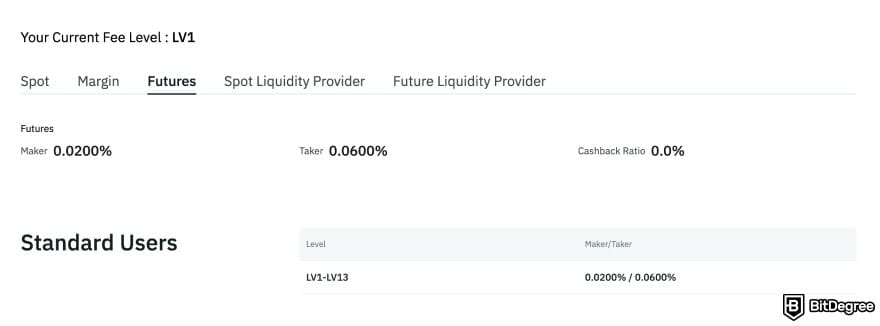
It’s especially beginner-friendly, as you don’t need to hit high volumes or VIP levels to enjoy competitive rates.
That said, there’s no cashback system for futures because the ratio is 0.0%. So if you’re a high-frequency trader looking for rebates, this might feel like a downside.
Still, you can unlock fee discounts through the VIP tier system and by using BMX, which I’ll cover next. It’s a nice boost if you’re planning to stick with the platform.
Other BitMart Fees
BitMart also has additional fees, including VIP programs, discounts, and liquidity provider programs. While these won’t matter much if you’re just starting out, they’re good to know as you level up your trading game.
VIP Fees
BitMart’s VIP program offers discounted trading fees based on your 30-day trading volume and BMX token balance. The best part is that you don’t need to be a whale. Just holding BMX can unlock fee reductions without massive trading volume.
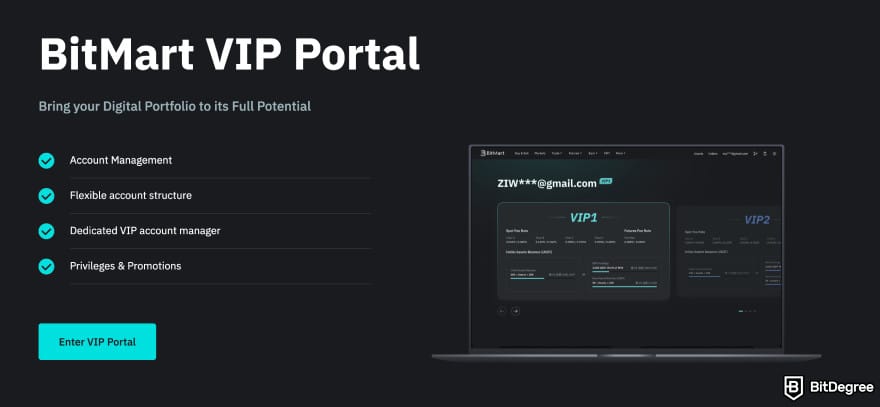 Joining as a VIP also gives you access to some nice perks:
Joining as a VIP also gives you access to some nice perks:
- A dedicated VIP portal;
- Flexible account structure;
- Access to exclusive promos and events.
So if you're planning to trade more actively or already holding BMX, it’s worth checking out how far up the tiers you can go.
API VIP Fees
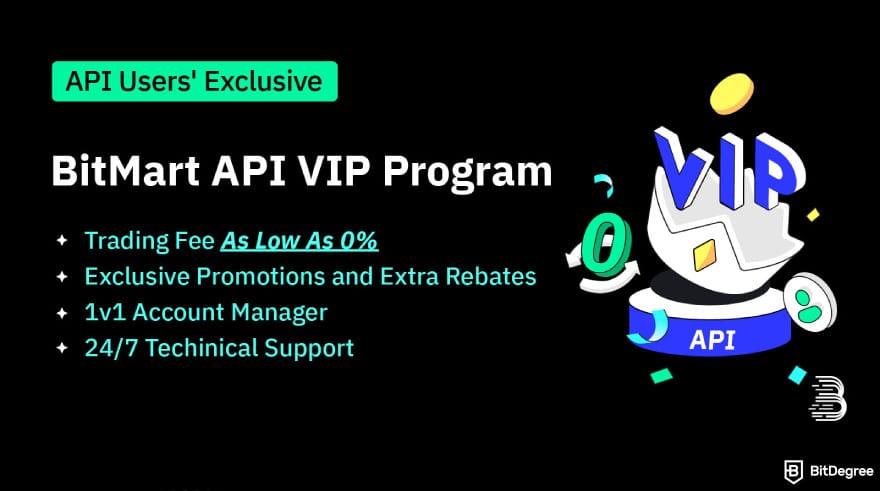 BitMart also offers special benefits to high-usage API traders through a separate VIP structure. It’s a way to give back to users who actively contribute to the exchange’s API system, which launched back in 2018. Key benefits include:
BitMart also offers special benefits to high-usage API traders through a separate VIP structure. It’s a way to give back to users who actively contribute to the exchange’s API system, which launched back in 2018. Key benefits include:
- 0% fee for spot trading via API;
- VIP perks and higher rate limits;
- Support for algo traders and external volume.
All new registered members can enjoy the API VIP3 fee level on BitMart during their first 30 days. Plus, your adjusted trading fee tier will then depend on your past 30-day cumulative trading volume.
But note that if you're enrolled in the free trial or the API VIP Program, the 25% fee discount for paying with BMX does not apply.
📚 Read More: What Is Trading Volume?
Liquidity Provider Programs
If you’re running bots or placing frequent limit orders, BitMart’s Spot Liquidity Provider (SLP) and Futures Liquidity Provider (FLP) programs might be a good fit.
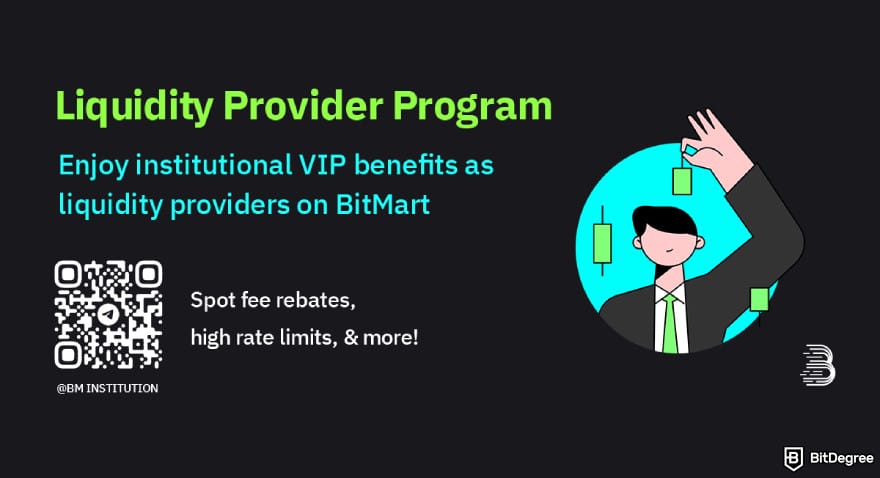
These programs reward you for helping keep the markets liquid. The benefits include:
- Reduced trading fees;
- Cashback or rebates;
- Bonus incentives for higher volume traders.
The way I see it, it’s a win-win setup. You help BitMart’s markets stay active, and in return, you get rewarded.
BitMart Fees: What Users Say
To get a better sense beyond the numbers, I reviewed what real users are saying about BitMart fees on Trustpilot.
One five-star user review praised the platform for its low fees. But on the flip side, a three-star user feedback mentioned that BitMart fees are higher compared to Binance, MEXC, and KuCoin. Another trader was surprised by a 0.5 USDT withdrawal fee for a BEP-20 transaction.
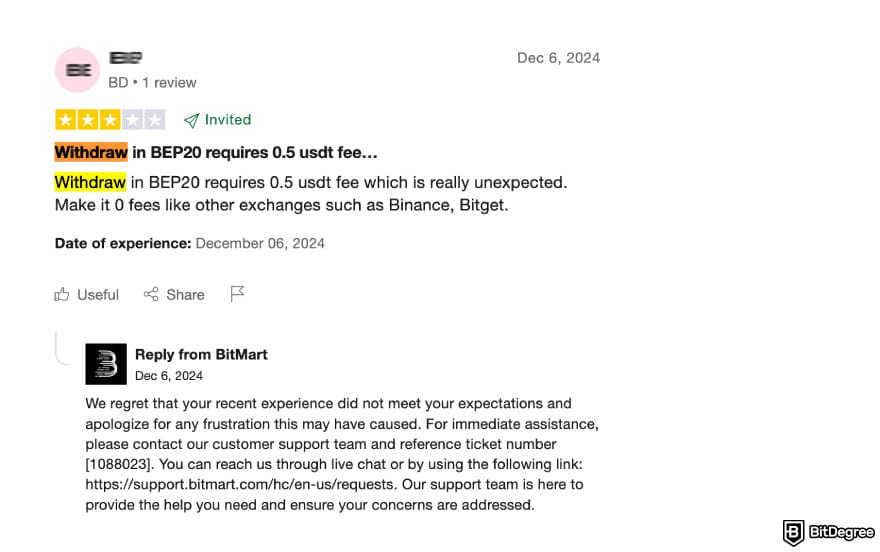
The key takeaway here is to always check fees before confirming a trade. Later in the article, I’ll also share some quick tips to help you cut costs on BitMart, like using BMX or timing trades during promos.
Comparing BitMart Fees With Other Exchanges
Now, let’s compare BitMart fees with other exchanges like Binance, Kraken, Bybit, and Coinbase. Here’s a quick overview of how they differ across various fee types, from deposit to futures trading.
Fee Type | BitMart | Binance | Kraken | Bybit | Coinbase |
|---|---|---|---|---|---|
Deposit Fees | Free | Free | Depends on the deposit method and currency | Free | Depends on the deposit method |
Withdrawal Fees | Depends on the currency | Depends on the currency | Depends on the currency | Depends on the coins and chains | Depends on the currency, payment method, and location |
Internal Transfer Fees | Free | Free | Free | Free | Free |
Spot Trading Fees (crypto trading pairs) | From 0.1% to 0.6% for makers and takers (12 levels) | From 0.1% to 0.011% for makers, from 0.1% to 0.023% for takers (10 levels) | From 0.25% to 0% for makers, from 0.40% to 0.08% for takers (11 levels) | From 0.1% to -0.005% for makers (15 levels), from 0.1% to 0.015% for takers (13 levels) | 0.6% for makers and 1.20% for takers |
Futures Trading Fees | Flat fee: 0.02% (makers) and 0.06% (takers) | From 0.02% to 0% for makers, from 0.05% to 0.017% for takers | From 0.02% to -0.005% for makers, from 0.05% to 0.01% for takers | From 0.02% to -0.005% for makers (15 levels), from 0.055% to 0.028% for takers (13 levels) | From 0.6% to 0% for makers, from 1.20% to 0.05% for takers |
Table: Comparison of BitMart fees with Binance, Bybit, Kraken, and Coinbase
From the table, BitMart holds up pretty well in terms of the basic fee structure. That said, platforms like Binance and Bybit offer lower trading rates for high-volume users, and Kraken can even reward makers with negative fees.
Next, I’ll break down the differences with each exchange so you can see where BitMart shines and where others might offer more value for your investment.
BitMart Fees VS Binance Fees
When it comes to trading fees, Binance is often the benchmark and for good reason. It’s known for offering low rates across spot, margin, and futures trading. BitMart performs well, but there are a few notable differences.
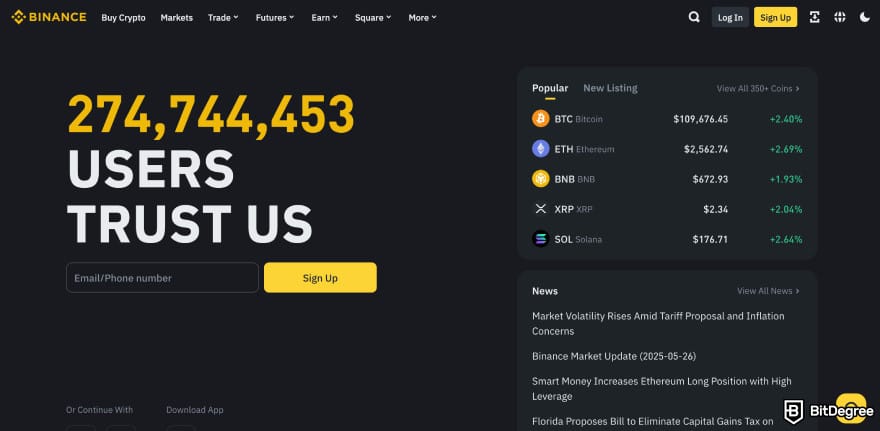
Both platforms start with a standard 0.1% maker and taker fees on spot trades. However, Binance drops its fees further if you climb the VIP tiers to as low as 0.011% for makers. BitMart has 12 levels, too, but the lowest is 0.6%.
For futures trading, BitMart uses a flat rate: 0.02% for makers and 0.06% for takers. Binance, on the other hand, offers more flexibility. The fees start the same but can drop all the way to 0% (makers) and 0.017% (takers) for top-tier users.
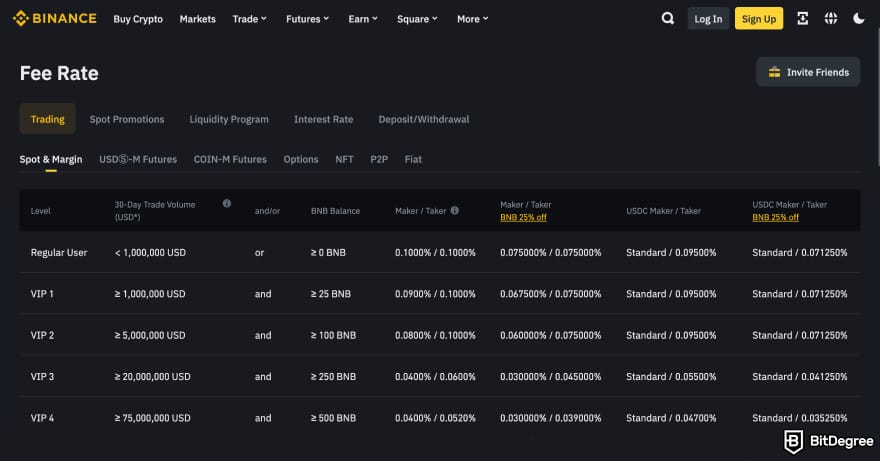 Both exchanges let you save more by paying fees with their native tokens - Binance Coins (BNB) and BitMart Tokens (BMX), respectively. You can save up to 25% for spot and 10% for futures on either platform.
Both exchanges let you save more by paying fees with their native tokens - Binance Coins (BNB) and BitMart Tokens (BMX), respectively. You can save up to 25% for spot and 10% for futures on either platform.
If you're new to Binance and want to take advantage of fee discounts, here's a quick guide on how to buy BNB.
As for withdrawals, Binance offers structured fiat withdrawal options (like SEPA and IDR), while BitMart withdrawal fees vary based on the crypto and chain. Still, both offer free crypto deposits and free internal transfers.
📚 Read More: Binance Fees
BitMart Fees VS Bybit Fees
BitMart and Bybit are fairly close in terms of fee structure. Both use tiered systems and cater to a similar type of trader. But there are some differences that may influence your decision.
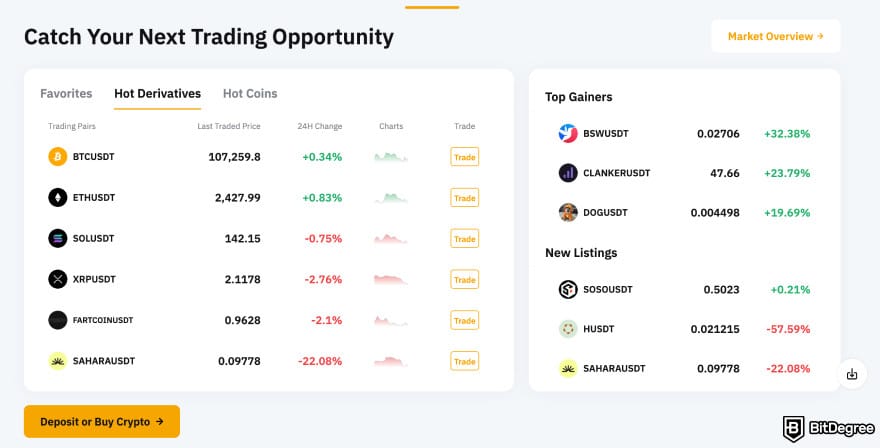 BitMart spot trading fees are between 0.1% and 0.6%, depending on your level. Bybit fees range from 0.1% to -0.005% (maker) and from 0.1% to 0.015% (taker). If you’re an active trader who qualifies for higher tiers, Bybit becomes the cheaper option.
BitMart spot trading fees are between 0.1% and 0.6%, depending on your level. Bybit fees range from 0.1% to -0.005% (maker) and from 0.1% to 0.015% (taker). If you’re an active trader who qualifies for higher tiers, Bybit becomes the cheaper option.
For futures, BitMart sticks with a flat 0.02% maker and 0.06% taker fee. Bybit fees range from 0.02% to -0.005% for makers, and from 0.055% to 0.028% for takers.
Both exchanges offer free deposits and internal transfers, so BitMart transfer fees only apply when you’re moving assets off the platform.
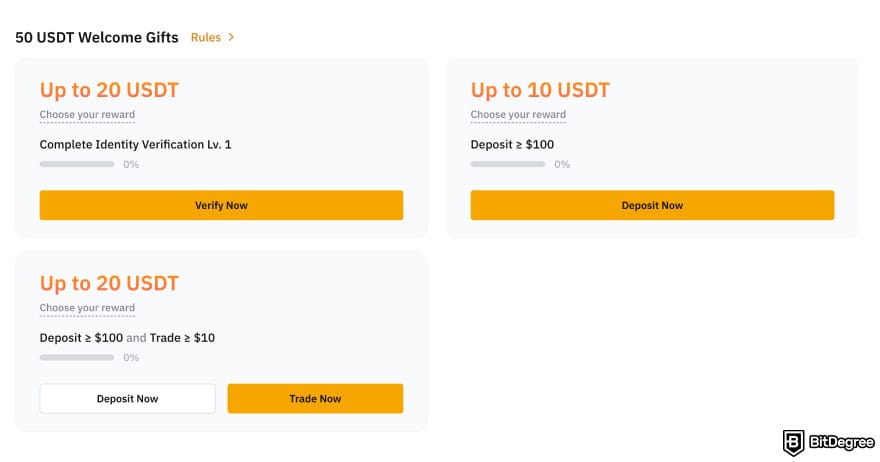
As one of the cheapest crypto exchanges, Bybit also stands out with its rewards and promotions. New users can often earn bonuses, and its VIP program is accessible. Plus, you can qualify either through trading volume or total asset balance.
So if you want extra perks for being active, Bybit could be a better pick.
📚 Read More: Bybit Review
BitMart Fees VS Kraken Fees
Kraken fees are solid but lean toward traders who deal with fiat. If you're focused on crypto-to-crypto trading, BitMart might be easier to navigate.
Spot trading on Kraken starts at 0.25% (maker) and 0.40% (taker), which is noticeably higher than BitMart’s 0.1% starting point. But Kraken rewards high-volume users as well - its fees can drop to 0% and 0.08% at higher tiers.
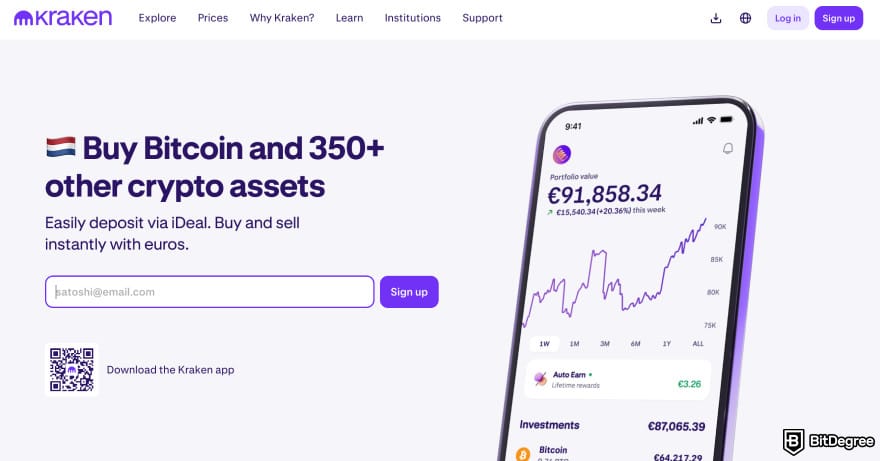
Futures trading is where Kraken gets aggressive. The fees can go as low as -0.005% for makers (meaning you actually earn for adding liquidity) and 0.01% for takers. That beats BitMart’s flat 0.02% and 0.06%, especially for whales.
📚 Read More: Kraken Review
BitMart Fees VS Coinbase Fees
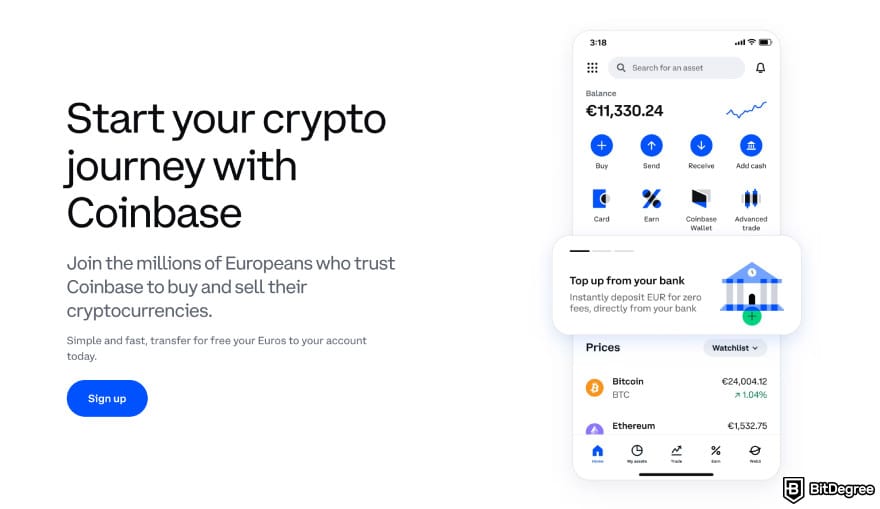
When it comes to BitMart fees VS Coinbase fees, the difference is pretty noticeable, especially if you're trying to save on trading costs.
Both platforms offer free internal transfers, but Coinbase brings in more variables. Your final fees might depend on your region, the payment method used, trade size, or even the current market conditions.
On Advanced Trade, Coinbase charges a flat 0.6% for makers and 1.20% for takers. BitMart, by comparison, keeps things lighter, with spot trading fees ranging from 0.1% to 0.6%, and futures trading fees at 0.02% for makers and 0.06% for takers.
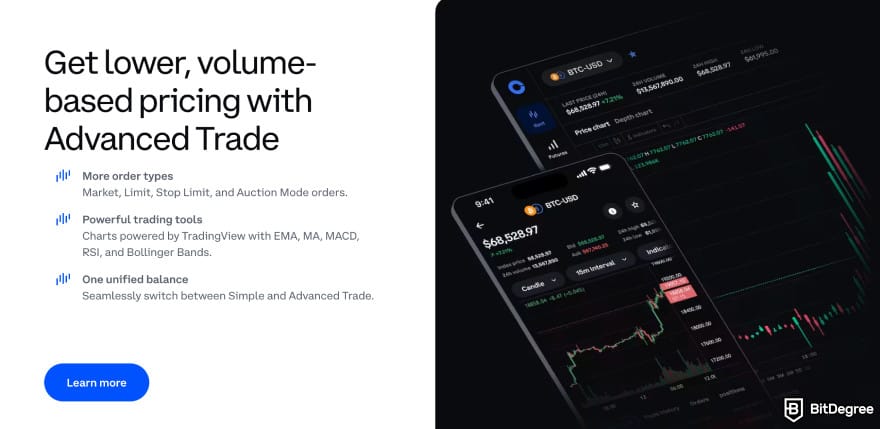
Furthermore, Coinbase’s fiat options are more robust. ACH is free, while SEPA deposits cost €0.15, and wire transfers can go up to $25. But if you’re sticking with crypto, BitMart’s free deposits and simpler structure may be more appealing.
Where Coinbase shines is in user experience and regulatory clarity. But in terms of raw fees, BitMart keeps it leaner, especially for crypto-only traders.
📚 Read More: Binance VS Coinbase
Tips to Optimize Your BitMart Fee Spending
If you’ve ever thought, “Are BitMart fees too high?”, you’re not alone. While the platform offers competitive rates in many areas, there are still smart ways to keep more funds in your pocket. Here’s how you can trade smarter and save more.
Use BitMart Token
Using BitMart’s native token BMX gives you an automatic 25% discount on trading fees. For example, if your regular trading fee is 0.1%, using BMX brings it down to 0.075%.
That might not seem like much at first, but it adds up fast, especially if you're making frequent trades or reacting to volatile crypto prices.
That said, it’s worth checking if this fits your strategy. Since the discount only applies when paying with BMX, make sure it’s a token you actually want to hold.
If you're trading regularly, this is one of the simplest ways to save without changing how you trade.
📚 Read More: Where to Buy BMX
Use Limit Orders
A limit order is a type of trade where you set the price you're willing to buy or sell at. The trade only goes through if the market hits that price.
Why does it matter? Because using limit orders makes you a maker, not a taker. On BitMart, maker fees are lower than taker fees, which can help reduce your overall trading costs. If you’re using market orders by default, you’re likely paying more than you need to.
When placing a trade on BitMart, simply choose the [Limit] tab instead of the [Market] tab. Enter the price you want and the quantity, then click the [Buy] button. In this example, it’s [Buy BTC].
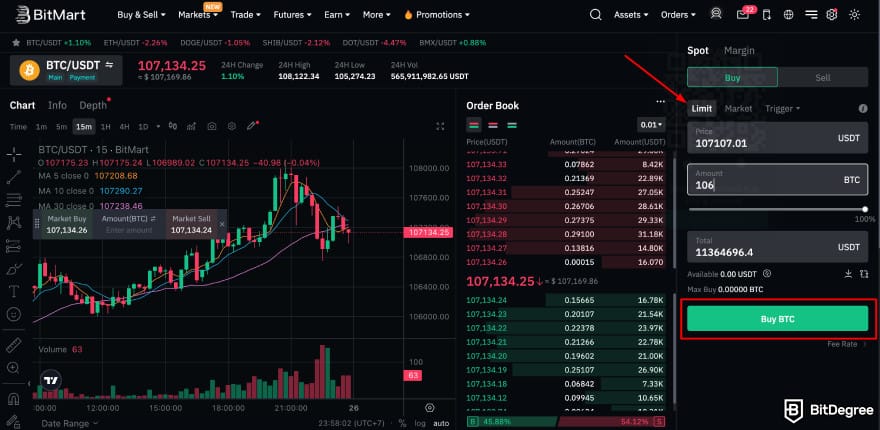 If you’re not in a rush to buy or sell instantly, using limit orders is a smart move to keep your fees lower over time.
If you’re not in a rush to buy or sell instantly, using limit orders is a smart move to keep your fees lower over time.
Withdraw on Weekends
Gas fees tend to drop when the network is quieter, and that's more common on weekends. If you're looking to save a bit, timing your withdrawal for a Saturday or Sunday could mean paying less in blockchain fees.
To find the best time, check live gas prices here before making a move.
![]() And there’s more going on behind the scenes. Miners may sometimes include fewer transactions per block[2] to keep total fees higher and discourage new competition. This means higher congestion could cost you more, even beyond standard network demand.
And there’s more going on behind the scenes. Miners may sometimes include fewer transactions per block[2] to keep total fees higher and discourage new competition. This means higher congestion could cost you more, even beyond standard network demand.
📚 Read More: How to Cash Out Ethereum

- Secure and reliable
- Accepts fiat currencies
- Lots of trading options
- Reputable exchange
- Accepts fiat currencies
- Offers various trading options

- Huge trading variety
- Regulation-compliant around the globe
- Fair trading fees
- Beginner-friendly
- A wide array of features
- Vast number of different crypto coins & tokens

- Beginner-friendly
- Secure
- Decent trading and withdrawal fees
- Crypto.com Visa Card
- Automated tools & bots
- Ecosystem synergy with CRO
Time Your Trades During Promotions
BitMart regularly runs promotional events that reduce or even eliminate trading fees. One example is BM Discovery, where selected spot pairs go 0% fee for a limited time.
You can find these deals on the Promotions page or keep an eye on their events page. Just make sure to check the terms - zero-fee usually applies only to specific pairs or volumes.
When in doubt, line up your bigger trades during these events. It’s an easy win.
📚 Further Reading: How to Use BitMart Exchange
Conclusions
So, are BitMart fees too high? Based on everything we’ve looked at, not really - at least not for most users. Spot and futures trading fees are quite competitive, especially if you use BMX for the 25% discount.
Deposit fees are free, and withdrawal fees depend on the token and network, similar to most exchanges like Bybit or Kraken.
But BitMart is also cheaper in some areas. For example, when comparing BitMart fees vs Coinbase fees, Coinbase charges 0.6% for makers and 1.2% for takers, while BitMart ranges from 0.1 to 0.6%.
However, keep in mind that the real costs add up based on how you trade. If you’re not using limit orders or you’re skipping fee promos, you might be paying more than you need to.
The content published on this website is not aimed to give any kind of financial, investment, trading, or any other form of advice. BitDegree.org does not endorse or suggest you to buy, sell or hold any kind of cryptocurrency. Before making financial investment decisions, do consult your financial advisor.
Scientific References
1. Kim, D., Ryu, D., Webb, R.: ‘Determination of Equilibrium Transaction Fees in the Bitcoin Network: A Rank-Order Contest’;
2. Shao, E., Rajapaksa, D.: ‘Miner Competition and Transaction Fees’.
